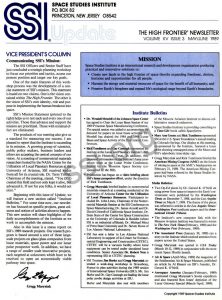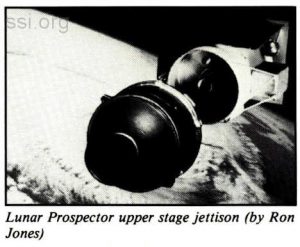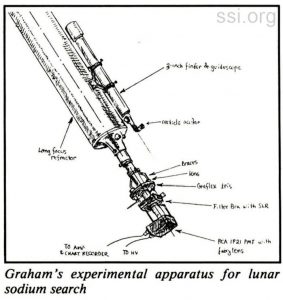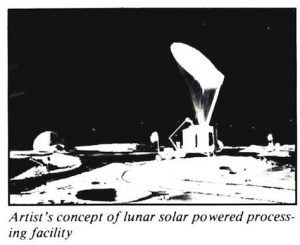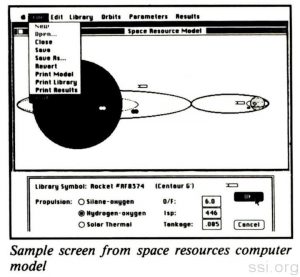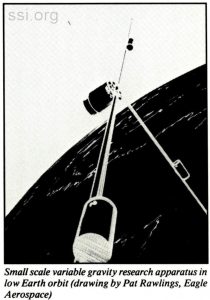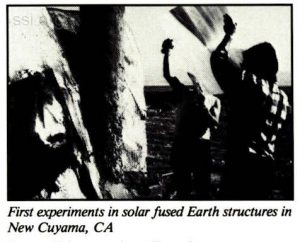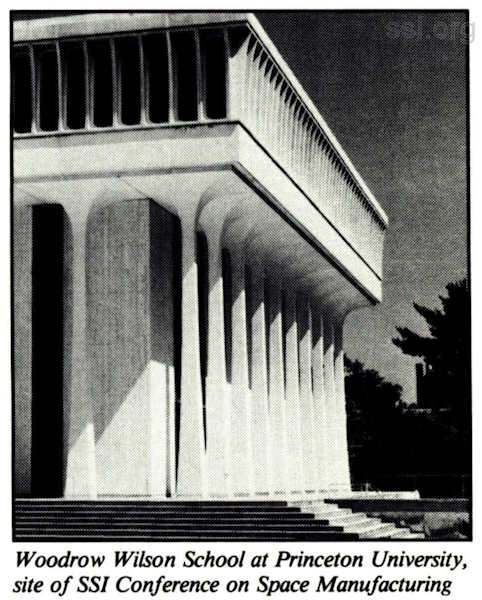SPACE STUDIES INSTITUTE
P.O. BOX 82
PRINCETON, NEW JERSEY 08542
[[librarian note: This address is here, as it was in the original printed newsletter, for historical reasons. It is no longer the physical address of SSI. For contributions, please see this page]]
SSI UPDATE
THE HIGH FRONTIER® NEWSLETTER
VOLUME XV ISSUE 3 MAY/JUNE 1989
VICE PRESIDENT’S COLUMN
Communicating SSI’s Mission:
The SSI Officers and Senior Staff have just concluded a strategic planning workshop to focus our priorities and tactics, access our present position and target our key goals.
One of the main features of this workshop process was the development of a concise statement of SSI’s mission. This statement is based on two visions. One is the vision contained within The High Frontier. The other is the vision of SSI’s own identity, role and purpose in implementing the human breakout into space.
SSI’s Mission Statement (printed to the right) helps us to test each and every one of our activities. Those that advance and support the mission are prioritized. Those with minimal effect are eliminated.
The products of our meeting also give us a standard for measuring our success. I am pleased to report that the Institute is succeeding in its mission. A growing group of scientists, public policy makers, business leaders and others are accepting the central concepts of our vision. At a meeting of nonterrestrial materials researchers hosted by the NASA Center for the Utilization of Local Planetary Resources at the University of Arizona, SSI received kudos from all for its crucial role. Dr. Terry Triffet, Chairman of the meeting, stated, “You (SSI) created this field and not only kept it alive, but advanced it. If not for you folks, it would not exist.”
Beginning with this issue of Update, we will feature a new section called “Institute Bulletins.” For some time now, our newsletter has focused on specific projects, guest columns and notices of activities about to happen. This new section will share highlights of the daily accomplishments of the Institute as we work to accomplish the mission.
Also in this issue is a status report on SSI’s 1989 research projects. Our research program is based around a core of three largescale projects on glass/glass composites from lunar materials, space power and our lunar polar prospector work. In addition, we have a range of smaller scale innovative projects, each targeted at unknowns which have to be resolved to open an economically viable pathway into space.
Gregg Maryniak
Institute Bulletins
• Dr. Wendell Mendell of the Johnson Space Center has agreed to Chair the Lunar Bases Session of our 1989 Princeton Space Manufacturing Conference. The special session was added to accommodate the demand for papers on lunar bases activities. Dr. Mendell has chaired the 1984 and 1988 Lunar Bases and Space Activity of the 21st Century Conferences.
• Rick Tumlinson and Gay Canough represented the Institute at the Lunar and Planetary lnstitute’s 20th meeting in Houston, Texas. In addition, they presented information on the Institute’s lunar prospector work at the Lunar Probe Conference, hosted by the Houston Space Society (cosponsored by the SSI).
• Production has begun on a video briefmg about SSI’s lunar prospector effort, under the direction of Rick Tumlinson.
• Gregg Maryniak briefed leaders in nonterrestrial materials research at a meeting conducted at the University of Arizona Center for the Utilization of Local Planetary Resources. Participants included Dr. John Lewis, Chairman ofthe Nonterrestrial Materials Session at the SSI Conference on Space Manufacturing; Dr. James Arnold and Dr. David Criswell of California Space Institute, Dr. Stein Sture of the Center for Space Construction at the University of Colorado in Boulder (where SSI is an industrial affiliate); Dr. Michael Micci of Penn State University and Dr. Steven Howe of Los Alamos National Laboratory.
• SSI has sent a letter to Los Alamos National Laboratory in support of its Center for Extraterrestrial Engineering and Construction (CETEC). CETEC will be a vacuum facility where lunar equipment can be tested under simulated lunar conditions. Senior Associate Dr. Robert Ness is representing SSI in CETEC planning.
• SSI Trustees Jim Burke and Gregg Maryniak attended a week-long workshop in Strausborg, France to plan activities during the 1989 session of International Space University (ISU). Mr. Jim Burke and Dr. Gay Canougb are leading the lunar polar probe design activities at ISU. Burke and Maryniak also met with members of the Moscow Aviation Institute to discuss collaborative research endeavors.
• Space Studies Institute is providing consulting to a Time-life book called Spacefarers.
• Mary Ann Grams and Rick Tumlinson represented SSI at the U.S. Space Foundation’s annual meeting in Colorado Springs. Our display at this meeting, co-sponsored by the Institute, featured a lunar globe showing unmapped areas of the Moon and SSI’s telerobotic time-delay rigs.
• Gregg Maryniak and Rick Tumlinson briefed the American Mining Congress on the future of mining in space at the AMC’s headquarters on February 21, 1989. The American Mining Congress had been referred to the Space Studies Institute by NASA.
Media Bulletins:
• Two Op-Ed pieces by Dr. Gerard K. O’Neill on using power from space to improve the Earth’s environment were published by the Washington Times on December 7, 1988, and the Los Angeles Times on March 7, 1989. The theme of the pieces was reflected in articles in the Los Angeles Times/Washington Post syndicate papers and the International Herald Tribune.
• The Institute’s new computer link with the Moscow Aviation Institute was featured in stories in The New York Times (February, 1989) and the Washington Post (February, 1989).
• The Associated Press (January 30, 1989) ran a story on the Institute which received attention from papers across the United States.
• Gregg Maryniak was quoted in USA Today (March 10-12, 1989) in conjunction with the most recent Space Shuttle launch.
• Air & Space (April/May, 1989) the magazine of the Smithsonian Air & Space Museum, published an article by Al Rienert on SSI’s founder, Dr. Gerard K. O’Neill.
• Aerospace America (January/February, 1989) mentioned Gregg Maryniak’s Soviet expedition and also featured Ron Jones’ depiction of the Lunar Getaway Special (March/April, 1989).
SSI Research Project Status Report
By Gregg E. Maryniak
Executive Vice President
Throughout the history of our Institute, SSI has been proving critical technologies necessary to harness energy and material resources in space. Each research project is designed to fill in one of the gaps between our present knowledge and SSI’s vision of large scale human habitation of space, based on the use of resources beyond the Earth’s gravity well. The scope of the Institute’s projects range from collaborations between industry, academia and the Institute, to a series of “mini” projects and student/volunteer investigations. Large-scale projects, such as performing the bench chemistry to demonstrate the processing of lunar soils or the construction of prototype mass-drivers, have obvious value and are most often remembered by our members. However, some of our present large-scale projects, such as our lunar polar prospector effort and our examination of the use of external tanks (which ultimately led to a favorable Presidential directive), have resulted from initial small scale studies.
For purposes of clarity, this report groups projects by subject matter rather than scale. Several projects just now getting under way, and in a few cases, proposed efforts are included, in order to provide a complete picture of this year’s research activities.
PROSPECTING FOR SPACE RESOURCES
One of the first questions about space resources is where are they to be found? A second question is what elements are available at various locations? SSI’s investigations in space prospecting have ranged from Shuttle external tanks with known locations and known chemical compositions to possible Earth-Sun Trojan asteroids, at this time purely theoretical in nature. In addition to the work described below, the Institute is in contact with the planetary science community, particularly those organizations and individuals searching for asteroids and short period comets.
Lunar Prospector:
From the standpoint of space operations, one of the most critical mysteries of the Moon is whether or not water ice and other volatiles may be trapped in shadowed regions near the lunar poles. SSI has advocated the development of a simple, dedicated polar probe which could answer the question of the existence of the volatiles and provide a geochemical map of the entire lunar surface to augment the equatorial data provided by the Apollo missions. As you read this newsletter, the Institute will have just completed a special Lunar Prospector Workshop in Princeton. Also, James Burke, Gay Canough and I will be involved in additional work with a team of approximately 50 of the top graduate students in the world as part of International Space University. SSI is actively pursuing commercial and government launch options and a special meeting on launch services for this probe is planned for this summer.
Under a contract with the Space Studies Institute, ExtraTerrestrial Materials Corporation (ETM) and principal investigators, Larry Lehman and Gay Canough, are looking at the problems and opportunities posed by manmade objects in Earth orbit. The final report of their research will be presented at our Conference and published in the Proceedings.
Lunar Sodium Search:
Under SSI mini-contract, Frances G. Graham of Kent State University is conducting a search for sodium vapor on the Moon using ground-based spectroscopy. Sodium, which has been observed in comet tails, is much less volatile than water ice and might be an indicator of more volatile materials in the lunar polar areas. A paper describing this work is scheduled for our 1989 SSI/Princeton Conference on Space Manufacturing.
Essential to the vision of the High Frontier is the availability of abundant energy from the Sun in free space. At the Earth’s distance from our star, every square meter of surface sees approximately one kilowatt of energy.
Solar Power Satellites From Early Nonterrestrial Materials:
Previous SSI research has shown that over 99% of the mass of a solar power satellite (SPS) can be built from lunar materials. This results in a cost savings of about 97% compared with an Earth-launched power satellite.
SSI’s early studies on SPS construction assumed that any material known to be relatively abundant in lunar soil could be available as a construction feedstock. The Institute’s January 1988 Lunar Systems Workshop focused on the fact that some types of nonterrestrial materials will be more easily attainable than others, and that these early and easy forms of nonterrestrial materials may be utilized to accelerate the pace of economic development of space. Accordingly, SSI is examining the construction of solar power satellites (and space power precursors) from simple forms of nonterrestrial materials. These include spent Shuttle external tanks, (and their Soviet Energia counterparts), and lunar glass, iron and oxygen. This work is being carried out under contract to the Institute by Space Research Associates (SRA) of Washington State. SRA performed SSI’s 1983-86 Solar Power Satellite Project and results of their latest work will be available in preliminary form at our 1989 Conference on Space Manufacturing in Princeton.
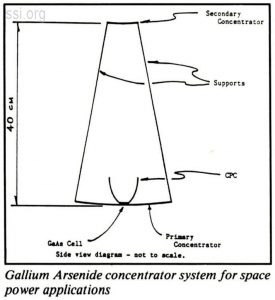
International Space Power Test Project:
Dr. Peter E. Glaser, father of the solar power satellite concept and Vice President of the Arthur D. Little Company, has proposed a space power transmission experiment for International Space Year (which will begin in 1992). This project will develop and demonstrate many of the essential technologies for precursors to full-scale solar power satellites. Virtually all of the present or proposed space projects in the world today are constrained by electrical power limitations. The development of power transmission will pave the way for solar power satellites, both technologically and as a means of bootstrapping the economic development of large space projects. Dr. Glaser is the principal investigator for SSI’s research in this area. As of this writing, the Institute is concluding the terms of our research agreement on this project, and additional details will be announced shortly.
PROCESSING NONTERRESTRIAL MATERIALS
SSI’s research on transforming raw lunar soil into construction feedstocks is concentrating on relatively simple processes which can produce construction materials using simple, rugged low-mass equipment.
Solar Powered Glass/Glass Composite Pilot Plant:
SSI is presently working with AlcoaGoldsworthy Engineering of Torrance, California to develop a solar powered pilot scale system for producing glass/glass composite components from lunar simulant. Previous work by Brandt Goldsworthy and Charles Coggin produced glass fibers from simulant and a lower melting temperature glass matrix material. These have been combined to form composites. Negotiations are presently under way with a large aerospace corporation to form a three part team to construct the pilot plant.
Magnetic Benefacation of Iron From Lunar Soil:
The Institute has aided Dr. Robin Oder of Exportech in a project to demonstrate new techniques for removing native iron from actual lunar soil samples. SSI has supported this work by providing the investigator with lunar simulant data and a quantity of specialized simulant material. Based on this information and runs performed on the physical simulant, Dr. Oder has been successful in obtaining permission to use actual lunar soil samples to continue this work and the Institute is receiving contract monitor briefings.
Iron as a By-Product of Ilmenite Reduction:
The proposed project looks at physical processing techniques to recover iron from the by-product of ilmenite to obtain oxygen is being studied by a number of researchers, and iron may prove to be an important co-product. Negotiations are presently under way with the research team and details will be announced when these negotiations are complete.
Lunar Simulant Survey:
Simulated lunar soil provides an essential means for testing processs and equipment for lunar use. Under contract to the Institute, researchers at the University of North Dakota have compiled an extensive listing of all lunar simulant work which has taken place in the U.S. and abroad (including the Soviet Union). The Lunar & Planetary Institute has advised the lunar science and engineering community of SSI’s work and we are now fulfilling requests for this research data from all over the United States.
TRANSPORTING SPACE RFSOURCES
Mass-Drivers:
The principle barrier to using resources in space is the present cost of space transportation. Central to SSIs’ vision is the development of the electromagnetic Mass-Driver. Mass Drivers will be used both to deliver material onto the “plateau” of free space from the surface of the Moon, and as reaction engines for certain space missions.
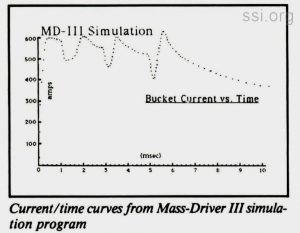
SSI’s principal mass-driver investigator is Dr. Les Snively. Dr. Snively, who constructed Mass-Driver III, has just completed a detailed computer simulation of mass-driver operation based upon the experimental results obtained in SSI’s hardware experiments. (Copies of this simulation are available, by special arrangement, to researchers familiar with the “Smalltalk” object-oriented computer language.)
Using this newly developed tool, Dr. Snively is now accessing the possibility of implementing new high temperature superconducting materials for the mass-driver bucket coils.
High Altitude Mass-Driver:
The Institute is engaged in a feasibility study of the use of mass-drivers to launch material into near-Earth space.
External Tank Propellant Scavenging:
In 1988 SSI held a workshop on methods for scavenging residual hydrogen and oxygen from Space Shuttle external tanks. The workshop was attended by Martin Marietta and Atomic Energy of Canada. Dr. D. Spagnolo of Atomic Energy of Canada will present a Poster Session paper on the use of new catalyst materials developed by his organization for external tank propellant scavenging systems in space at the 1989 Conference on Space Manufacturing.
SYSTEM STUDIES
The overall planning of complete systems for the use of nonterrestrial energy and materials is an essential part of SSI’s work. As various research projects are completed and new knowledge gained, we are able to “finetune” our plans.
The results of the Institute’s systems studies have been published by the AIAA (Low Profile Road to Manufacturing in Space, 1978; New Routes to Manufacturing in Space, 1980) and by the Lunar & Planetary Institute Proceedings (First Steps to Manufacturing in Space, [in production]).
Space Resources Computer Model:
Work is continuing on the creation of a program containing the essential parameters for space resource utilization and transportation. The purpose of the program is to serve as an educational model to enable researchers and students to see the effects of changes in transportation, energy requirements and other parameters. Principal investigators for the project are Dr. Andrew Cutler and Ms. Mari Hughes.
Space resources will enable the construction of large free-flying human habitats, which are a principle goal of the Institute. In our opinion, space colonies will arise first out of an economic need for long-term, safe, comfortable habitats for space workers engaged in such projects as solar power satellites, and ultimately, as an end in themselves.
Space Colony Artificial Gravity Project:
In recent years, the Institute has examined the possibility of relatively small scale space habitats with all of the essential attributes of a permanent home in space. These include closed-cycle life support, radiation shielding and artificial gravity. Of these attributes, artificial gravity is the one area about which there is virtually no hard data. While most scientist believe that some level of gravity will trigger normal human physiological response in such areas as bone calcium and immune system behavior, no one knows what that threshold level will be.
Consequently, SSI has strongly advocated the development of test facilities where experiments with animals and humans can develop the necessary information which will enable us to design systems for long-term human habitation.
Under the direction of Dr. Jeff Shephard, SSI has instituted a mini-project to design experiments to gather this data, prior to the construction of large scale space stations. The feasibility of early experiments using modest facilities is being explored.
Space Colony Interior Design:
Most of the work on space habitats was conducted in the 1970s, under the direction of Dr. O’Neill, in several NASA sponsored summer studies. Since that time, the Institute has been mainly involved in enabling technologies to provide materials and energy for human habitats in space. We have, however, instituted a new mini-project under the direction of Mr. Paul Klaus of the University of Kansas, to look at designs for habitat interiors. We are providing partial support for Mr. Klaus’ Masters Thesis work in this area, with particular emphasis on utilization of trees and other vegetation in space habitat interior planning. Mr. Klaus has worked on the interior design of Antarctic bases and has “wintered” over in the Antarctic as background for this endeavor.
VOLUNTEER PROJECTS
Throughout the history of the Institute, our research projects have been carried out with the help of professional investigators who do the work primarily as a labor of love. As a result, our research projects typically cost about 1/10th of what a commercial contractor would charge. In that sense, virtually all of our work has been carried out by “volunteers.” At this time, we have two projects under way which have been developed specifically by volunteer groups.
Solar Fused Soil Structure Experiments:
In a project instituted by SSI Senior Associate Joseph Kennedy, we are examining the use of solar fused soil elements for structures and for the paving of landing pads, roads and other components of lunar infrastructure. Using Fresnell Lenses supplied by the Institute, Mr. Kennedy is demonstrating the production of fused soil components. Recently, he has been joined in his work by his mentor, noted architect Nader Khalili, who has pioneered terrestrial applications of ceramic and fused soil structures, particularly in the Third World.
Lunar Teleoperations Experiments:
For the past year, a team of SSI volunteers, led by Rob Lewis of the GE Astro Space Division, has conducted inexpensive experiments and demonstrations in teleoperation at lunar distance. Using a series of low cost robots and custom designed delay units, teleoperation has been shown to be feasible with a 2.7 second round-trip time delay. Test subjects for these experiments have included graduate students from the International Space University, students at Princeton University and a host of senior members of the research and aerospace community, who have found the apparatus intriguing. An interesting spinoff of the research work has been the use of this equipment in education and displays. The SSI traveling exhibit has been completely mobbed by visitors to scholarly conferences such as Space ’88, hosted by the American Society of Civil Engineers.
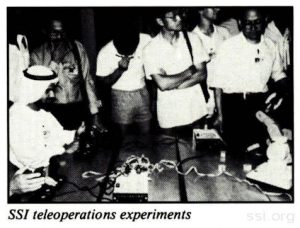
At present, SSI is also working with the Franklin Institute in Philadelphia to create a museum exhibit on lunar teleoperation.
RESEARCH MATRIX AND DATABASE
A team of SSI volunteers, headed by Bob Summersgill and Carole Kingsbury in Washington, is experimenting with an information matrix/database to enable researchers to locate work in a variety of research subjects and career and interest areas. For example, someone interested in looking into the legal aspects of lunar mining could find, at the intersection of law and lunar resources, references to work performed in that area.
Liaisons With Other Research Organizations:
In addition to our in-house research, SSI is tracking work by a host of other organizations and is working in consort with researchers in space solar power, closed cycle life support and nonterrestrial material production. Some of our alliances include the NASA Center for Space Construction in Boulder, Colorado, where the Institute is an industrial affiliate; the University of North Dakota Energy Research Laboratory; Los Alamos National Laboratory, with whom we are discussing a lunar test facility; and the University of Arizona’s NASA Center for the Utilization of Planetary Resources.
SSI/PRINCETON CONFERENCE ON SPACE MANUFACTURING
Central to any field of study is a forum for publication of research papers and the presentation of ideas. In nonterrestrial materials and space colonization, our biennial Conferences on Space Manufacturing are the glue that holds the research community together. The proceedings are published by the American Institute of Aeronautics and Astronautics (AIAA), a co-sponsor of the Conference. These Conferences and their associated literature form the core of accumulated technologies necessary to achieve the human breakout into space.
©space studies institute
NEXT: 1989 July August (9th Conference, Letter to SSI from the President of the United States)

